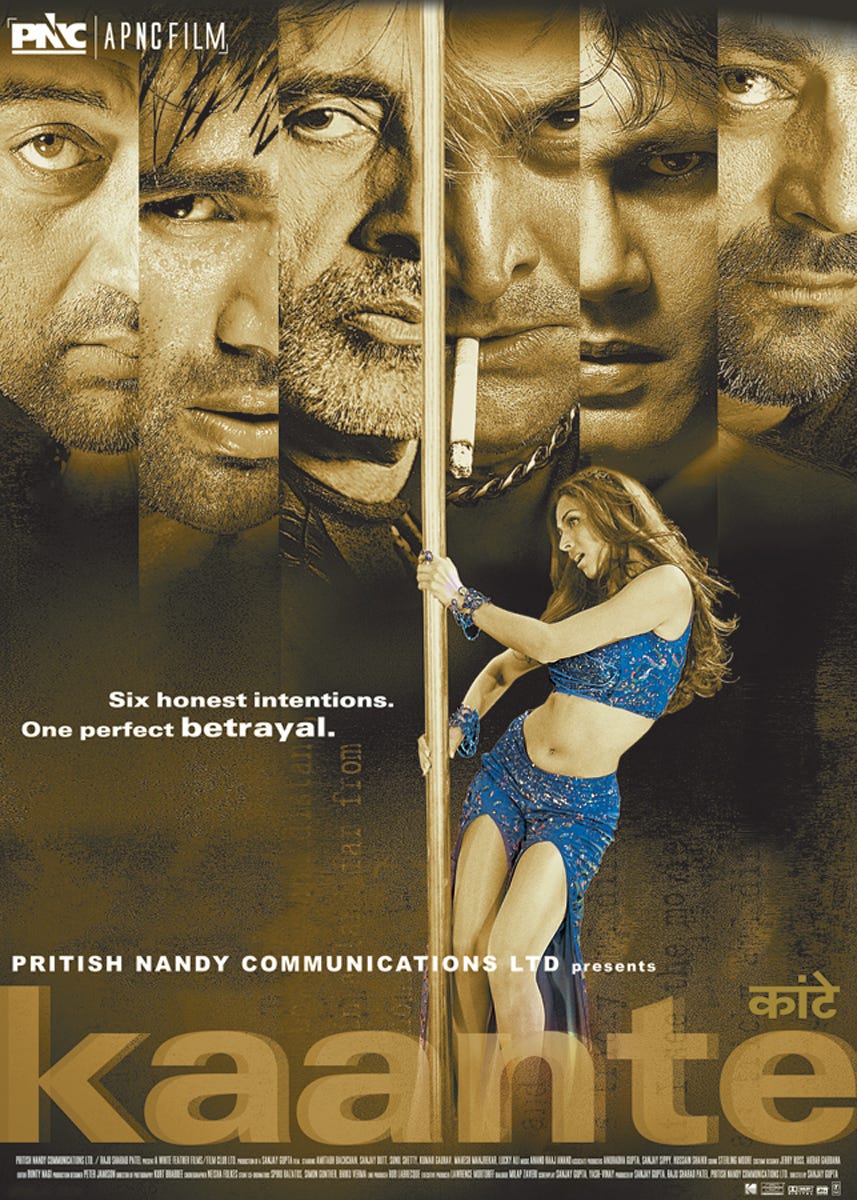By Sumeysh Srivastava


Sholay is an essential part of Indian cinematic history and has had a lasting impact on Indian pop culture. Almost all the famous scenes and songs are well known, and its characters, from the Jai-Veeru pairing, Gabbar himself, have served as the inspiration for many other personas across Indian cinema. . . Sholay itself was inspired by numerous western movies, specifically Seven Samurai and the numerous spaghetti westerns famous during the late 60s and early 70s.
One of the most eternal components of the movie is the song “Mehbooba Mehbooba.” During the song, Helen, as the ubiquitous (in Salim-Javed movies) cabaret dancer, distracts the bandit Gabbar Singh, Soorma Bhopali, and their henchmen, while Jai and Veeru lay down mines and destroy their camp and supplies. Legendary as the song is, you may know that it was copied from the song “Say You Love Me” by Demis Roussos. This isn’t surprising; Our cinematic history is littered with songs, characters, as well as full movies “inspired” by western and regional cinema.
In this post, we are going to look at a few examples and see how copyright works in this regard. Before we move further, let’s see how the law defines a few key concepts.
- Author: This is quite simple, the author with respect to any work is the person who causes the work to be created. There are different definitions of who the author is based on the nature of the work. For example, in the case of a book, the author is literally the author! In case of song, it’s the composer and in case of a movie, it’s the producer. There are more definitions given based on the nature of the work.
- Copyright: In law, copyright means that the author of any work, as mentioned above, has the right to decide how other people can use that work. The work can only be used if the author of the work gives permission.
- Fair Dealing: This is an exception to the rule of copyright given in Section 52 of The Copyright Act 1957. Basically, the idea of Fair Dealing means that it is okay for a person to reuse a work that is under copyright, as long it is done in certain limited amounts and for a specified purpose. Check the section to know about this in more detail
Now, let’s take a look at a movies and see how the law dealt with copyright infringement in their case.
BANDA YEH BINDAAS HAI
A popular film favourite among lawyers and law students is the 1992 Oscar-winning comedy, My Cousin Vinny. The film features Joe Pesci as a quick-witted but hapless attorney defending two innocent New York teens from a capital murder charge in the Deep South. In 2009, Twentieth Century Fox filed a suit for copyright infringement in the Bombay High Court against the Mumbai-based film production company, BR Films, which was set to release Banda Yeh Bindaas Hai. Twentieth Century alleged that the producers and director of ‘Banda Yeh Bindaas Hai’ blatantly created a “substantial reproduction” of ‘My Cousin Vinny’. Both parties agreed on a settlement amount out of court under Section 89 of the Civil Procedure Code. This section of the law allows for mutual settlement between parties without intervention of the court.
KNOCK OUT
In Twentieth Century Film Corp. v. Sohail Maklai Entertainment, the producer Sohail was accused of unlawfully copying and remaking Twentieth Century’s 2002 thriller Phone Booth’under Section 2(m)(ii) of the Indian Copyright Act, 1957. This section explains what “infringing copy” means. With respect to a movie, it means a copy of the film made on any medium by any means. Phone Booth’s premise concerns a sniper who holds an unfaithful publicist hostage in a phone booth and demands that the publicist confess his infidelity to his wife. The sniper toys with his hostage and threatens to kill him if he does not obey the sniper’s commands. The plot of the accused film, ‘Knock Out’, is centered on a sniper who holds an unfaithful man hostage in a phone booth. However, ‘Knock Out’ incorporates a political conspiracy plot into the script along with song-and-dance sequences.
The court said “it is enough that substantial parts were lifted; no playwright can excuse wrong for showing how much of his work he did not pirate.” The court held that copyright infringement could be found even when a small part is substantially similar to the copyrighted work and concluded that there is copyright infringement. The matter was settled amicably between both the parties with a settlement amount of 1.25 crore rupees given by Sohail Maklai to the Twentieth Century.
RAABTA
Raabta was recently slapped with a copyright infringement suit by the producers of the Telugu film Magadheera. Both films involve lovers who find each other in a second life (reincarnation). Other similarities include parallel visualization of the two different “births” or generational settings — with the previous one being a royal, medieval setting. And both films have a notable antagonist vying for the woman’s affection.
Later, the suit was withdrawn under Order 23 Rule 1 of the Civil Procedure Code as the parties agreed to an out of court settlement instead.
PARTNER
Let’s consider the popular 2005 Hollywood film Hitch. Alex Hitch is a professional “date doctor” who coaches other men in the art of wooing women. While coaching one of his clients, Albert, on how to impress his client Allegra, Hitch finds himself falling in love with a gossip columnist, Sara. However, none of his methods to court her work. While pursuing his love interest, Hitch keeps his career a secret. After finding out the truth about Hitch’s job, Sara publishes an exposé on Hitch, resulting in the breakdown of the relationship between Albert and Allegra. In the end, Hitch tells Sara the truth about the unsavory Vance, salvages the relationship between Albert and Allegra, and resumes his relationship with Sara.
In 2007, Bollywood released the film Partner about a love guru, Prem, who solves the love issues of his clients. A character named Bhaskar approaches Prem for help on how to woo his boss, Priya. Another character, Naina, finds out about Prem’s job and sets out to expose him, resulting in the breakdown of the relationship between Bhaskar and Priya. In the end, Prem makes up with Naina by telling her the truth and Priya and Bhaksar are reunited.
The two films are nearly identical. Overbrook Entertainment, along with Sony Pictures, contemplated a $30 million lawsuit against the producers of ‘Partner’. Although cease and desist letters were sent to the makers of ‘Partner’, talks of a lawsuit soon faded.
A cease and desist letter is a written communication, demanding that the receiver “cease and desist” from actions that infringe the sender’s legal rights or ownership. It threatens lawsuit if the alleged violation of the sender’s rights or ownership does not stop, and compensation for violations that have already taken place. It is thus an enforcement strategy to settle a dispute without litigation. A cease and desist notice in a copyright action may give rise to the right to institute a suit under Section 60 of the Copyright Act to counter such a threat, and ask for relief if there is no alleged infringement of the legal right of the sender.
KAANTE
Sanjay Gupta’s star-studded Kaante features Amitabh Bachchan, Sanjay Dutt, Suniel Shetty, Kumar Gaurav, Mahesh Manjrekar, and Lucky Ali as bank robbers who plan a heist. It is plagiarised from Quentin Tarantino’s ‘Reservoir Dogs,’ in whichsix bank robbers are involved in a diamond heist gone badly wrong. There were no legal proceedings in this case. We just mentioned it because this is probably the only case where the inspired movie was embraced by the makers of the original. In fact both the movies were screened together as a double bill screening!


There are so many more examples we could add, but for the sake of brevity, we will refrain from doing that. However, we can see the pattern that emerges from the examples given above. Getting into long drawn court battles is something that no one seems to prefer, especially if it means a delay in the release of a movie. Out of court settlements seem to be the best option for both parties. Of course, recently we have started seeing that producers are willing to make official remakes and buy the rights for regional as well as western movies to be remade. That is the whole point of copyright law. Not only does it ensure that the author’s rights are protected, it also ensures that the author can make money from sharing their work.
Sumeysh Srivastava is Programme Manager and Senior Resident Fellow at Nyaaya. Views are personal.


